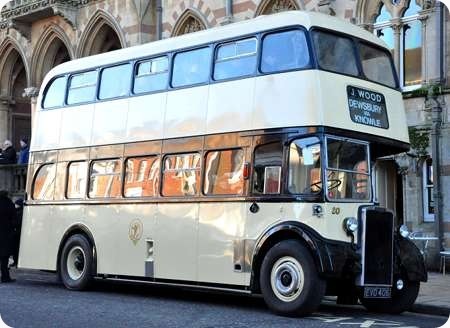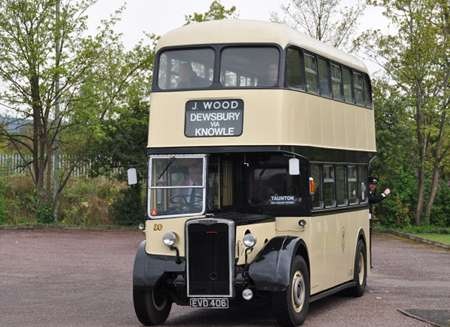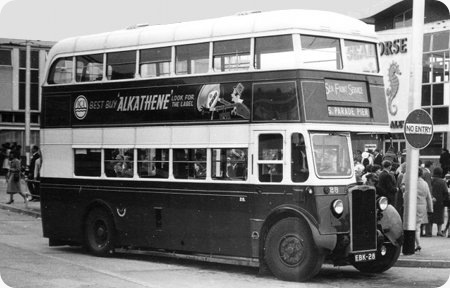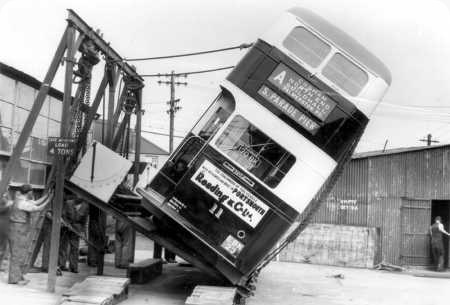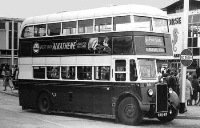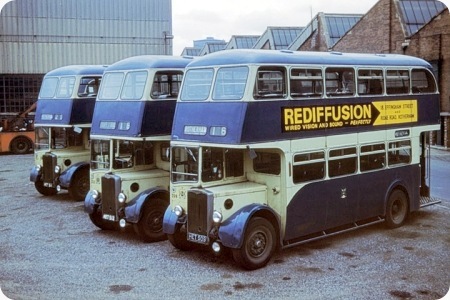
Copyright John Stringer
Rotherham Corporation
1952
Crossley DD42/8
Crossley H30/26R
Lined up at Rotherham Corporation’s rather gloomy depot in 1968 are 211, 212 and 209 – 1952 Crossley DD42/8’s with Crossley bodywork to their later four-bay design. The HET-registered batch were the very last ‘proper’ Crossleys ever built. They must have been near to withdrawal, if not already withdrawn, because very shortly afterwards 213 – the last Crossley ever delivered (though 214 was numerically the last) was presented to the British Transport Museum, but turned up in my home town, on indefinite loan to Halifax Corporation, where the GM – Geoffrey Hilditch – was assembling a fascinating assortment of old buses to present in that year’s 70th Anniversary Parade (see Roger Cox’s Gallery – 1968 Halifax Parade). It remained there for a few years, even being called upon to perform Driver Training duties on occasions in the early 1970’s. It was entered in the 1973 Trans-Pennine Rally, and I had the privilege of driving it back from Harrogate to Halifax – my only Crossley driving experience. Despite all the criticism heaped on the make over the years, and though it was a bit on the slow side with rather heavy steering, I still found it a pleasant bus to drive, with a lovely gear change, and it was one of the nicest riding buses I have ever driven. So there !
Photograph and Copy contributed by John Stringer
———
12/04/12 – 06:22
To be fair John, it was parsimonious management and badly designed engines that did for Crossley and there are probably a lot of people out here who would agree with you. AEC helped, but it came too late, and the bodies continued and were, for the most part, very good.
David Oldfield
———
12/04/12 – 06:23
Hi John,
Splendid line up of Crossleys’.
This body design already seems to have some Park Royal influence even by 1952, as did some Roe bodies of the same period.
Eric Bawden
———
12/04/12 – 17:58
As well as the Rotherham Crossley Halifax had an ex JMT TD1 and an ex-Red Line AEC Regal. When Geoff Hilditch went to Leicester the trio were used on a round the park service on the occasion of the depot open day to mark the end of open platform buses in October 1982. Also there was a one and a half deck trolleybus that came from Leicesters twin town Aachen. The Crossley is in the Science Museum Reserve collection the fate of the others is unknown.
Chris Hough
———
13/04/12 – 06:08
Is the Aachen Trolley the one at Sandtoft which looks like the result of a nasty accident?
Joe
———
13/04/12 – 06:08
My previous post wrongly ascribed the one and half deck trolley to Aachen rather than Krefeld. Apologies to all in Leicester.
Chris Hough
———
13/04/12 – 06:09
I travelled on these Crossleys on many occasions on service 69 from Sheffield to Rotherham when I spent 5 months at a basic training workshop at Parkgate, just up the road from the Rotherham Depot. I always felt that Rotherham buses were somewhat inferior to those of my native Sheffield. I can only ever remember Rotherham’s Crossleys turning up on the 69 although doubtless other makes must have been used on occasions. The final leg of my journey to Parkgate was by Mexborough and Swinton, usually on a lowbridge Atlantean – I still recall that Mexborough and Swinton seemed to have 100% conductresses on their buses. They also acquired several batches of Leylands of varying types from Southdown which gave added interest.
Ian Wild
———
13/04/12 – 06:09
Hilditch’s vintage collection also included an ex-JMT Leyland Lion PLSC (repainted into Edinburgh livery for an appearance in the film ‘The Pride of Miss Jean Brodie’), and an ex-Swindon Guy Arab II with wonderfully original Weymann utility body. The Regal was actually ex-Red Bus, Mansfield. It was petrol engined, and a fine bus indeed. There was also a mightily impressive bonneted Leyland Lioness all weather coach.
John Stringer
———
14/04/12 – 07:05
The Krefeld trolleybus is part of the Aberdeen and District Preservation Trust and is kept at the Grampian Transport Museum at Alford in Aberdeenshire.
Stephen Bloomfield
———
14/04/12 – 08:14
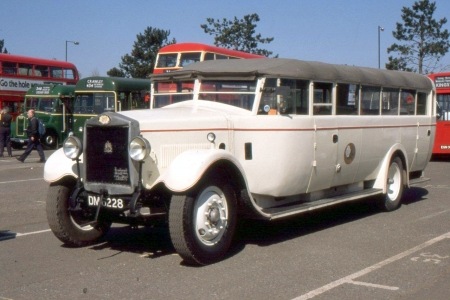
Copyright Bob Gell
This is the Leyland Lioness referred to by John Stringer, which I photographed at Cobham in April 2002. Quite a magnificent vehicle!
A few years ago (2005), the Red Bus Regal and the Swindon utility Guy were in the Science Museum Reserve Collection at Wroughton, Wiltshire. They seem to have occasional Open Days and it is well worth a visit.
Bob Gell
———
25/11/12 – 08:25
Having once had the pleasure of driving Oldham 368, I can totally agree with John Stringer’s view of the Crossley driving experience. However, unlike most people I am not convinced that it was the Crossley engine that did for the company. By all accounts AEC’s modifications solved the problems well enough, and if the market had remained buoyant I see no reason why Crossley’s fortunes should not have revived. But in fact the bottom dropped out of the bus market in 1950, at which point wartime shortages had all been alleviated and most tramway conversion projects completed. This left the bus manufacturing industry as a whole with too much production capacity, and what nobody ever mentions is that Crossley was in the uniquely vulnerable position of being totally reliant on bus production for its survival (the Crossley Brothers engine builder being a separate concern). Everyone else had other activities to dilute the effect of the reduction in bus orders – cars in the case of Daimler, and goods vehicles in all other cases – but Crossley simply had nothing else to do.
Peter Williamson
———
25/11/12 – 11:14
There’s a good deal of truth in Peter’s observations but Crossley’s was also a cast iron case of "give a dog a bad name", coupled to the fact – borne out in time – that the ACV group would not support the marque as a separate entity.
The badging of the prototype Bridgemaster as a Crossley, an odd thing to do with a vehicle aimed primarily at BET, may have raised hopes in Heaton Chapel but was very much a false dawn, as was the badge engineering of Regent chassis as Crossleys and BUT trolleybuses and the use of Park Royal’s body designs by the body building side of the business.
Many publications and "those in the know" point to the move across the boundary to Stockport as a factor in Manchester’s rejection of the marque – some say THE major factor in the demise of the business – but, whilst politics and the local economy certainly played a major part in Crossley obtaining and retaining Manchester’s business up to the engine problems, and then Stockport’s after the move – hardly a like for like swap(!), I’ve not seen any evidence of the rejection being other than based on sound technical and business grounds.
Manchester, unlike Birmingham, another major Crossley user, certainly continued to order vehicles in quantity on an annual basis throughout the 1950s. The two chassis type policy (Leyland and Daimler) adopted by Manchester was at the behest of A F Neal, not the politicians, at a time when Manchester was very much involved in getting the best out of its Crossleys and, given a large proportion of the workforce were Manchester ratepayers, had there been any belief in the long term future for the type within the excellence of the ACV group, there would have been no good reason for Manchester to abandon the breed.
Phil Blinkhorn
———
27/11/12 – 07:27
Again, I’m not convinced that further patronage from MCTD would have made a great deal of difference to Crossley, given the sudden drastic reduction in the operator’s annual requirements. If "The Manchester Bus" is to be believed, all buses delivered up to and including 1951 had been ordered (in principle if not in detail) back in 1945/6, so that the decision not to buy any further Crossleys had no effect until at least the 1953 deliveries, by which time AEC had pulled the plug. And even if they hadn’t, what then? Triple sourcing for only 100 vehicles per year would not have done Crossley a great deal of good. And MCTD was hardly likely to abandon Daimler after discovering the delights of Gardner engines and fluid flywheels. I just don’t see it.
Peter Williamson
———
27/11/12 – 13:11
Historically, Manchester was Crossley’s biggest customer for both bus chassis and bodies. In the 1930s,for political reasons, the Transport Committee insisted that the bulk of orders go to Crossley. From the beginning of 1930 to the end of 1940 no less than 772 chassis were delivered and Crossley either built, finished or provided frames for around 800 bodies, both figures include trolleybuses.
From 1945 to 1950 (1951 in the case of trolleybuses) 355 all Crossley buses and trolleybuses were delivered plus a further 50 bodies on the CVG5s, out of a total of 598 deliveries of all makes received by MCTD, a further 100 all Leyland/Leyland MCW vehicles from the immediate post war orders being delivered in 1951.
The Phoenix bodied Daimler CVG6s, delivered in 1950/1 were not ordered until 1948 but I can’t state with certainty if this was before of after AEC’s purchase of Crossley, I suspect the latter.
It is obvious from the work that went on between MCTD and Crossley during WW2 on both chassis and, particularly, body development that Manchester was still very much linked to Crossley as its major supplier.
Back in the 1930s Stuart Pilcher had persuaded the Transport Committee to accept Leyland tenders as a second string supplier so all his eggs wouldn’t be in the basket of a company that wasn’t always consistent in its product development and production.
The Daimler orders in the run up to war were only placed because Crossley were directed by government to concentrate on military production and Pilcher wasn’t going to be left bereft of vehicles in his drive to rid Manchester of trams.
Had Crossley heeded Manchester’s interest in the Gardner/Wilson combination instead of its own power/drivetrain ideas it probably would have survived the down turn.
Albert Neal was frustrated by Crossley’s intransigence over the HOE7 debacle. We don’t have records of the many meetings and phone calls to back up the letters that exist between the two concerns but it is a safe bet that long before the AEC takeover a decision had been forming to reduce the dependence on Crossley and the takeover changed the thinking from a reduction of dependence to total divorce.
The Phoenix bodied CVG6 order was the first indication to the outside world of the way the wind was blowing and in 1949 the Transport Committee formally confirmed that the Department’s policy would, in future, be split 50/50 Leyland and Daimler with MCW as the preferred body builder.
So how does my contention that Manchester’s continued patronage of Crossley would have saved the company stand up?
It is true that the general bus market declined after the rash of orders immediately following the cessation of hostilities. The figures, however, speak for themselves. Manchester took delivery of no fewer than 601 vehicles between the last of the post war orders which for the sake of my argument has Leyland 3299 being the last, and the end of December 1958 – the 601 thus includes the Phoenix bodied Daimlers.
Based on previous ordering patterns, had Crossley listened to Manchester’s needs, they would certainly have picked up the orders that went to Coventry (270 chassis)and there is every reason to believe that a good proportion of the orders that went to Leyland would have gone to Errwood Park. As there was great satisfaction with the bodies Crossley had produced or finished, again it is almost certain a good proportion of the bodies required would have emerged from Errwood Rd, especially given Neal’s dislike of the early MCW Orion offerings.
As it turned out Errwood Park did get a final order from Manchester for 62 BUT trolleybuses (basically Regent chassis with locally produced Metrovick control gear) but Burlingham got the body contract, Piccadilly wanting nothing with a Crossley badge and justified the vehicles under its two chassis policy as BUT was a 50/50 AEC/Leyland company.
So, with Crossley under the AEC banner but still active at Errwood Rd, why didn’t the Department buy locally produced motor buses especially as AEC eventually solved the engine problem and, given their willingness to have Gardner engines mounted on Regent chassis, would presumably have been more than happy to work with MCTD to produce a Gardner/Crossley combination which would have resulted in a reasonable flow of orders?
The answer is down to politics, but nothing to do with the move to Stockport. In the early 1930s Stuart Pilcher pressed hard to have orders for AECs approved, on sound technical grounds. The transport committee, given the Great Depression, insisted on orders going to Crossley and it might be said that the bus side of the business both survived and benefitted technically from the largesse of the Committee.
Albert Neal’s frustration with Crossley led to the two chassis supplier policy which was both technically and economically sound but why Leyland and Daimler to the exclusion of AEC/Crossley?
Firstly there was a great deal of "the dog having a bad name" thinking in the industry and in Piccadilly and Manchester Town Hall in particular and, for the time being, the ACV group were keeping the Crossley name.
Even more importantly, Leylands were made in Lancashire and were considered as "local" in terms of where the Committee’s money would end up. Daimler may have been in Coventry but Gardner engines were made in Patricroft.
AEC, on the other hand, made it plain from day one that all monies spent at Errwood Rd would be directed to the newly formed ACV and it was based in London!!
There have been statements in various publications that Crossley was too small to survive as a bus manufacturer but post war it managed to build 1114 DD42s chassis between 1945 and 1951 plus the trolleybuses for Manchester, Ashton and Cleethorpes and 1680 SD42/43 single deck chassis, 1175 of which were for a one off export order to Holland.
Those figures are hardly small and, in addition, they were also building bodies.
So, I return to my contention that had Manchester not pulled the plug Crossley would have survived, but having persisted with an engine that frankly didn’t work as advertised, they committed commercial suicide by not listening and working with their most loyal, consistent and largest regular customer.
Phil Blinkhorn
———
27/11/12 – 14:10
…..and of course Leyland learned from Crossley’s mistakes…..?
David Oldfield
———
27/11/12 – 16:22
David, you and I are old enough to realise that governments, economists and companies are too bound up with their own brilliance to take the time look around to see the mistakes of others and far too busy take the time to look back in history.
Phil Blinkhorn
———
27/11/12 – 17:37
Or, to quote (approximately) two often mentioned statements:
1. Those who ignore history are doomed to repeat its mistakes.
2. History teaches us that history teaches us nothing.
Stephen Ford
———
28/11/12 – 07:30
There’s an interpretation here that Crossley was an arrogant engineer led company devoid of commercial nouse that always thought they knew best and certainly there is some evidence to that effect. When they weren’t playing the ‘local jobs’ card with Manchester they played it with Stockport (though it’s probable that most of their employees lived in M/cr even after the move to Errwood Park as they had only to take a hop on a #19 to get from Gorton). Their bids for work were rarely the cheapest and when they were so there is a pattern of requests for subsequent price uplifts post contract. Failure to win a bid sometimes led to a request to retender on somewhat specious grounds.
I don’t think the move to Stockport had any part in the downfall of Crossley. Manchester would have continued to take Crossley product if it had been better served by Crossley. Crossley were the engineers of their own downfall, something that I guess ACV realised after the acquisition.
Smaller bus builders than Crossley with a much smaller customer base did survive, Dennis to name but one and which, in a very different form, is still around today.
Orla Nutting
———
28/11/12 – 15:50
I would suggest one of the main reasons for the demise of Crossley Motors was the fateful decision by the Managing Director, Arthur Hubble in late 1944 not to use the "Saurer Head" HOE7 engine, which had performed very well in the prototype Crossley DD42/1 (GNE 247). The engineers were instructed to redesign the engine to avoid Saurer patents infringements. This was a hurried operation, untested and the outcome was a mess. Sadly this redesigned engine was fitted to the production run of SD42 and DD42 buses from 1945 onwards up to 1949 and caused a lot of trouble. AEC engineers then came to the rescue to redesign the engine and produce the HOE7/5 downdraft version which was a big improvement but too late as the damage had been done. Was this a case of money taking precedence over engineering?
Richard Fieldhouse
———
28/11/12 – 15:51
Dennis, however, Orla, did not rely solely on building buses (which they dipped in and out of over the years), but also on municipal vehicles like dustcarts and fire engines and all-purpose lorries. It was the companies with all their eggs in one (bus) basket which often failed, as in other business dealings. I leave out arrogance, well covered above!
Chris Hebbron
———
28/11/12 – 17:15
In fairness to Peter’s point in regard to Crossley having nothing else to do when the orders slowed, every other chassis manufacturer did have other lines of production and a look at what those alternatives were highlights just how Manchester dependant Crossley had become:
Leyland, AEC, and Guy, all produced trucks with a broad customer base. Foden and Sentinel tinkering on the edge of the market had truck businesses.
Also Leyland and AEC bus divisions had good relationships with BET and a range of export customers
Dennis was in the middle of a fire engine replacement boom.
The two long established bus manufacturing companies most exposed were Daimler and Crossley.
Daimler, as Peter says, had car production but in 1953 when Geoffrey Hilditch joined the company for a very short time, he was aware of redundancies in the bus division and that the car division had been badly affected by increases in purchase tax and the concentration on high end vehicles which, whilst individually profitable, were sold in far smaller numbers, up to five times fewer, than the competing Jaguars which were also cheaper, Jaguar of course eventually buying out Daimler.
Two things saved Daimler bus production. Of immediate influence was the production of a quality product designed to the needs of a loyal and widespread customer base which, whilst rarely offering large orders, kept the lines working.
The company was really kept afloat by the very profitable Ferret armoured car which was ordered by the British army and over 20 export customers.
As Peter says, Crossley had nothing else. Car production had long ceased, only two prototype trucks were built post war and the British military that had been a major customer almost continuously since the WW1 abandoned the company – I wonder why? Did the same attitude that lost them Manchester’s business cause annoyance at the War Ministry and among the heads of the armed forces?
Due to production priorities at the Alvis factory, Crossley did produce just six Saracen armoured car pre-production models in 1956, well after the AEC takeover.
With regard to the Saurer head, there is an inference that Hubble hoped to get away with copying it without paying for a licence and the redesign was done hurriedly and badly under pressure of his irritation.
It’s ironic that the money it cost from an accounting point of view to redesign the head badly, taking in hours worked, overtime and tooling, wasn’t much less than he could have negotiated for a licence.
The real cost was, of course much, much more.
Phil Blinkhorn
———
28/11/12 – 17:22
Bradford had 6 Crossley DD42/7 buses which were fitted with the HOE7/5 engine to which Richard refers. As young enthusiasts in the early post war years, we were very aware that the BCPT Maintenance staff had a very low regard indeed for these buses, Nos.518 – 523. They were virtually restricted to one route, West Bowling, and were suitably disposed of at a very early date for post-war 8ft. wide vehicles. Neither did they find a purchaser!
This is not a personal dislike, as their official unpopularity tended to heighten our fondness for them, but for "Them that knew", they were hated with some vehemence!
John Whitaker
———
29/11/12 – 07:22
I do incline to Orla’s interpretation of the Crossley chronicles. The company did play politics to secure orders. The arrogance attributed to the Crossley company really lay with the Managing Director, Arthur Hubble. Although we do not now know what terms Saurer demanded for the use of its combustion chamber design (and the comprehensively researched book by Eyre, Heaps and Townsin has not been able to establish any figures about this matter), it does seem that the payment of a licence fee was the fundamental factor. Other manufacturers used Saurer technology very successfully – the Morris Commercial diesel engines of Saurer design continued in production into the Leyland era. The last minute revamp of the original Saurer HOE7 cylinder head demanded by Hubble was not received gladly by the Crossley design team, and the resulting motor was a dud in terms of reliability, economy and performance. Hubble’s innate obstinacy was revealed in other ways, also. Crossley steering was always heavy, a problem that could have been easily rectified by redesigning the steering geometry, but the company would not budge. Instead it replaced the races with thrust buttons that made a bad situation very much worse. When AEC took over Crossley, it insisted that the troublesome HOE7 had to be sorted out quickly, but Hubble resisted this strategy, and a frustrated AEC gave the job to its own engineers. The resulting "downdraught" engine was a major improvement, though it still inherited the crankcase weaknesses of the original Crossley design. Yet, despite the availability at last of a fully competitive engine by courtesy of AEC, Crossley continued to make and fit the old HOE7 to many new orders, even in some instances where the customer was expecting the downdraught version. After the success of the Birmingham order for 260 DD42/6 buses, AEC instructed Hubble to approach Gardner for an agreement for the supply of LW engines, Birmingham’s preferred power plant, thereby keeping Birmingham interested in future Crossley orders. The meeting between the intransigent Hubble and the autocratic Gardner family had an inevitable outcome, and Hubble reported back to AEC in obvious glee that Gardner would not supply Crossley with engines. Yet, in a very many aspects, Crossley got a great deal right, presumably in those areas where Hubble didn’t interfere with his engineers.The DD42 was a fundamentally sound chassis design, and Crossley constant mesh and synchromesh gearboxes were excellent. Whether, with a more sensitive hand than Hubble’s on the company’s tiller, Crossley would have remained in business for a longer period is imponderable now, but the certainty is that its reputation would have been significantly higher, a major factor in commercial success.
John, weren’t the Bradford Crossleys of the DD42/4 type, and delivered in 1948? At that date they would have been fitted with the standard HOE7 engine. Were they converted later to the downdraught HOE7/5 specification?
Roger Cox
———
29/11/12 – 07:24
Phil, the reason I said that all Manchester deliveries up to 1951 had been ordered (in principle) back in 1945/6 is that "The Manchester Bus" includes the Daimler/Phoenix orders in the 1946 order figures – originally just 50, but quickly increased to 90. That could, of course, be wrong. I didn’t know about the reason for Manchester going to Daimler in the first place.
On the subject of Crossley’s "attitude" problem, I have commented before (maybe not here) about how it seemed to be confined to chassis matters. The body division seemed willing to bend over backwards to do whatever the customer wanted. Strange that.
Peter Williamson
———
29/11/12 – 09:50
I am not sure Roger; I just know they were not liked by BCPT! We had a friend and neighbour who held a high position at Thornbury, and his comments were far from complimentary. I remember one school special when the Crossley was virtually unable to ascend Oak Lane, and drivers too hated them for their "slow gear change" They were banished to the short and fairly flat West Bowling route. Ordered in 1947, but not delivered until mid 1948, I have often wondered how other "hilly" systems coped with their DD42 Crossleys.
Lancaster is quite hilly, and they had DD42s, although I am not sure of just how exact such comparisons are. I am as certain as I can be that no alterations of a mechanical nature were made to our 6 Crossleys, but I am unable to confirm this as I would not now know who to ask!
20 minutes later
I have just "dug out" my BCPT stock book of the 1950s, and see that I have recorded 518-523 as type DD42/3, and they entered service in September 1948.
Another character defamation aimed at them was their weight, but I have to say that they did seem to demonstrate quality of build, and had a more luxurious air about them, as, indeed, did the 1952 Crossley trolleybus rebodies, which entered service early 1952.
John Whitaker
———
29/11/12 – 10:13
All really interesting stuff, folks. Do we have a date from which the HOE engine was dumbed down? Oh, those lucky early post-war orderers, whoever they were!
Chris Hebbron
———
29/11/12 – 10:57
Well, I’ve already said that they were distress purchases – when anything was better than nothing – and that the bodies were palpably a much better product than the chassis. I cannot say it better than any of the other correspondents. You cannot turn round in Sheffield without bumping into a hill but the Crossleys were put on the least hilly routes (ie with fewest hills per mile/route). The SD42s did venture out into Derbyshire – but presumably the lesser weight helped to make this possible. [Anyone have experience of SD42 coaches. How did they fare?]
David Oldfield
———
29/11/12 – 10:57
So much has been said about the miserable performance of postwar Crossleys – both on this site and for quite a long period in Classic Bus magazine (to the point where the editor had to end further correspondence if I recall). However, there are two points that never really seem to be raised.
The first is that we only here about the double deckers, but how did operators find the single deck version ? The SD42 was very common amongst independent coach operators – probably not through choice initially, more because in the postwar coaching boom they had to take anything they could get, but how did they perform ?
Secondly, if the main problem lay with the troublesome breathless engines and the rest of the design was pretty good, and their bodies excellent, what about the operators who subsequently re-engined theirs with Gardner/Leyland/AEC units ? Surely then they ought to have been good buses – problem solved ?
Does anyone know how these vehicles performed ?
John Stringer
———
29/11/12 – 10:58
It’s just occurred to me that this trio bear bodies of the same style as the Portsmouth Daimler CWA6’s that Crossley re-bodied in 1955. SEE: www.old-bus-photos.co.uk/
Chris Hebbron
———
29/11/12 – 14:44
Roger, I think I misquoted the HOE designation on an earlier post, and am now more confused than ever. I believe Bradford’s Crossleys, being 8ft. wide, should be classed as DD42/4, whereas I have always thought of them as DD42/3, even though I misquoted them as DD42/7 before! I will leave you technical experts to sort it out, and apologise for my "clouded enthusiasm", compounded by ever increasing senior moments!
John Whitaker
———
29/11/12 – 14:44
My good friend John W mentions in his Bradford stock book that 518 -523 were Crossley DD42/3 which I believe relates to the 7′ 6" width chassis whereas the Bradford Crossleys were 8′ wide. This means they should be coded DD42/4 as they were part of the 94 sanction. Could they have been ordered as 7 ‘6" but changed to 8′ width as there was a long period from ordering to delivery in September 1948 when 8’ width was legal?
Richard Fieldhouse
———
29/11/12 – 14:48
Peter, I just wonder if the difference in attitude between the chassis and body side of the business was because Hubble regarded the former as real engineering and a science and liked to interfere and the latter as far less worthy of his input.
It has always seemed to me that the excellence their bodies attained throughout their history matched the aspirations for their chassis and engines which were, certainly post war, rarely attained. If only the latter could have matched the former.
With regard to the chassis order eventually bodied by MCW with the Phoenix body, I understood that the sanction for a call for tenders was given for a bulk total of vehicles required up to 1951 by the Transport Committee in 1945. My reading of archive material, albeit 30 years or so ago, was that this did not include the CVG6s and probably did not include the Leyland bodied PD2s of the 32xx batch though Heaps and Eyre contend they were included in the total.
Heaps and Eyre state a total order of 763 vehicles was made between 1945 and 1946.
"The 1945 order was for 100 each from Leyland and Daimler and 109 from Crossley…..the 1946 order was for 100 Leylands, 50 Crossleys and 54 Crossley trolleybuses, followed by 100 more Leylands, 60 Crossleys and 50 Daimlers – the Daimler order was quickly increased to 90".
The catch is in the indefinite wording. The "100 more Leylands" were PD2s and the type was only available to order from 1947, though a demonstrator had been shown to some operators, not including Manchester, in the last months of 1946.
I believe those Leylands and the CVG6s were ordered in 1948. To back this up, Southport bought the first 8ft wide PD2s when announced in the autumn of 1947 and had received them all by the end of the year. A host of operators took PD2s of both widths in the period 1947-1950 yet Manchester, which needed vehicles for both tramway and obsolete vehicle replacement didn’t receive its PD2s until May 1951 deliveries stretching until February 1952. London had placed its order for RTL and RTW PD2s in early 1948 and Manchester’s order followed this, the London vehicles being delivered from 1950.
Similarly operators large and small were receiving Daimlers throughout the period 1946-1950 (indeed Manchester’s 1945 ordered CVG5s arrived and, to Manchester’s great exasperation, half the chassis had to be stored awaiting Crossley bodies, whilst the Brush bodied examples were delivered as intended in 1947/8).
I can see no reason to suppose Manchester delayed a total of 200 urgently needed vehicles when everyone else were receiving vehicles in sequence of order.
The CVG6s were, I believe, ordered as a hedge against the problems at Crossley and the second batch were added by Albert Neal when he ran out of patience.
Regarding Manchester’s move to Daimler pre war and to expand on my simplistic previous statement, on February 8 1939 the City Council approved a 3 year purchase plan to allow Pilcher’s tramway conversion. This did not include Daimlers but included 165 Crossleys (diesels and trolleys) out of 325 vehicles but it was soon obvious Crossley wouldn’t be able to cope, given the demands of the military.
The Council changed its mind and approved, after some heavy lobbying by Daimler, an order for 327 buses and trolleybuses 124 of which were Crossleys and 83 Daimlers. The reasoning was the promised delivery dates by Leyland and Daimler would reduce the time for tramway conversion by half and would guarantee delivery if war was declared – ironic given many of the Daimler chassis ordered were destroyed by enemy action.
The next order in July 1939 was changed from the planned 50 Leyland and 50 Crossley diesels to 33 Daimler, 33 Leyland and 34 Crossley.
The Council got it right. Crossley had delivered only a third of their allocation when they had to cease bus production, Leyland delivered everything on time and the Daimlers were delivered as required up until the time the factory was bombed.
Crossley suffered both financially and in terms of talent as some design staff left to join Leyland.
Phil Blinkhorn
———
 Vehicle reminder shot for this posting
Vehicle reminder shot for this posting
———
30/11/12 – 07:39
Re David O’s comments about Sheffield Crossleys – the initial batch of DD42/3s spent virtually all their working life on the Inner Circle Services 8/9 which had some fearsome gradients – Newbould Lane, Crookesmoor Road, Rutland Road come to mind. The Sheffield Crossleys were a small proportion of the fleet – but all the 1948 batch of DD42/5s ended up as driver trainers – maybe if you could drive a Crossley you could drive anything!!
Ian Wild
———
30/11/12 – 07:40
Chris, on the subject of the resemblance between the Rotherham Crossleys and the Portsmouth rebodied CWA6s, this has been discussed on the Portsmouth thread – see Chris Hough’s comment and my reply a couple of messages further down.
It’s not as straightforward as it may appear.
David and John: I have no personal experience of the SD42, but I have never heard anything bad about it, and quite a lot of good in fact. It seems that the engine could cope a lot better with the lower weight, and the refinement of the Crossley chassis was really appreciated by coach operators.
Peter Williamson
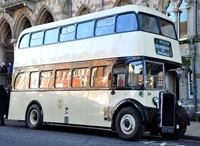 Vehicle reminder shot for this posting
Vehicle reminder shot for this posting